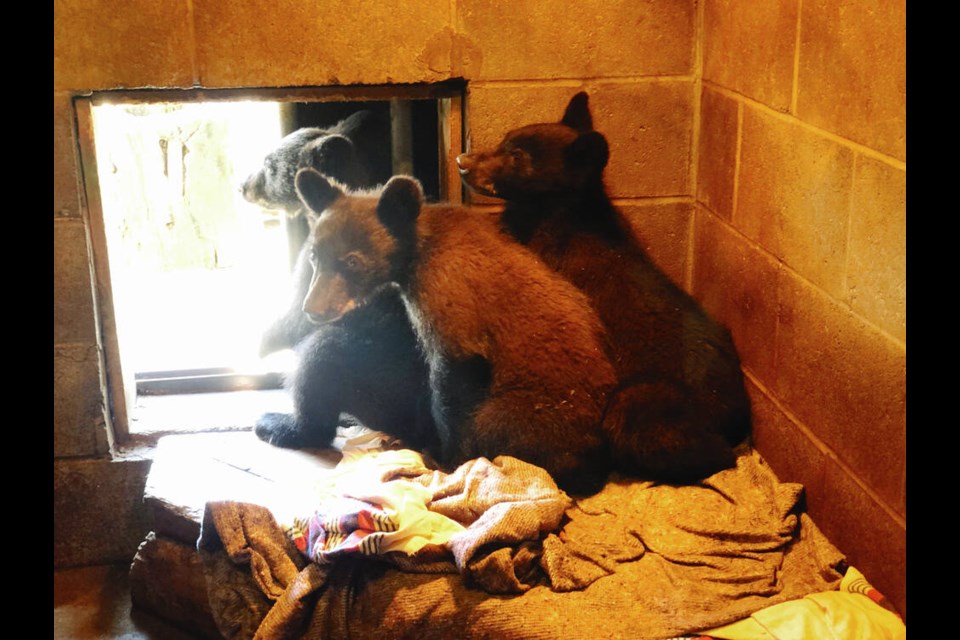The bear cub orphanage at Errington had just finished collaring, tagging and releasing five yearlings when a truck pulled in late Friday.
Three new cubs arrived at the North Island Wildlife Recovery Centre still under sedation and looking frightened and confused. The trio are siblings and their story, like the dozens of orphaned cubs before them, is a tragic one of bear interaction with humans.
In this case, their mother was shot by conservation officers near Thetis Lake for getting into garbage on park trails and climbing on house porches looking for food. The mother had been removed from aLangford neighbourhood in 2019 and, as a repeat offender conditioned to human food sources, got a lethal bullet.
Her offspring, however, will have a chance to be wild again, in about a year, as they are raised with minimal human contact at the Errington facility, which has raised and released about 200 black bears over the past 26 years.
Although sad, the timing of the new delivery was perfect for bear rehabilitator Derek Downes. The warrens of indoor and outdoor enclosures for bear cubs had just been cleaned.
He said Monday the new cubs appear to very healthy with good appetites.
“This morning they were running around, splashing through the water and climbing logs … natural bear behaviour, which is really what you want to see as the sedation wears off,” Downes said.
“They’re eating well and their stools look fine, so there’s no health concerns that we can see.”
He said the cubs were likely born in January or February. No sexes have been determined and won’t be until a veterinarian does initial health checks.
“For now we just leave them be, and let them get used to a new environment,” said Downes.
He said the cubs are being fed a specialized “omnivore kibble” with probiotics and fruits like apples developed over the years at the centre, as well as a bear milk replacement.
Sean Pendergast, section head for fish and wildlife based in Nanaimo, said five yearling bear cubs that were raised at the recovery centre over the past year are generally set free into the areas where they were recovered. This spring, a cub found near Sooke is back in the woods in that general area, a trio captured in the Qualicum Beach area were returned to the mid-Island and another was released west of Campbell River.
They are fitted with ear tags and GPS collars that track their movements, usually for between a year and two years before the collars and tags made of cotton and leather rot off, said Pendergast.
Some are perfectly happy where they are set free; others travel travel longer distances for a suitable spot.
But the tags and collars don’t always stay on. Bears often pull them off and some are removed within a few months as the yearlings can lose between 20 to 50 pounds within the first few months of release, said Pendergast.
He said data collected can show where the bears go for food and where they end up denning. He said most bears end up hibernating, during which time females give birth, but some don’t go for extended sleeps if food is plentiful.
Pendergast said the North Island Wildlife Recovery Centre program to raise bears has been a success in that it rears the cubs to have a healthy fear of humans. The facility has room for 10 bears, but has exceeded that total during some years.
But he said there is no way to determine the long term success of the program because the tags and collars are usually off the bears as they grow into adults. “That’s the missing piece of the puzzle,” said Pendergast.
He said there is no way of knowing if a young cub can pick up on habits taught by a mother — for example food is easy around humans. “Bears have good noses, very good memories,” he said. Relocated black bears have been known to travel great distances in short periods, with some ending up back where they were darted for eating garbage, said Pendergast.
Downes said he believes most of the cubs are thriving in the first years in the wild.
“To me, success is measured in getting these cubs healthy, with a healthy fear of humans, and acting like bears,” he said.
“Believe me, the love here is only one way. They don’t like us and that’s fine. That’s the way it should be.”
Downes said he would like to see the day when he doesn’t have to raise bear cubs, but said as long as people leave their garbage unsecured or throw waste out their car windows or leave it along park trails, bear orphans will keep coming.
Melanie Austin, who lives near Thetis Lake Regional Park where the mother bear was trapped and euthanized Friday, said it’s upsetting that a bear was put down because of food and garbage that wasn’t secured.
“It’s really heartbreaking because it feels preventable, so it’s unfair to the wildlife,” she said.
In a statement, the Conservation Officers Service said it can’t stress enough the importance of securing attractants to help prevent bears and other wildlife from accessing them. “It is the single best way to help keep the public, and bears, safe.”
— with a file from Roxanne Egan-Elliott
>>> To comment on this article, write a letter to the editor: [email protected]


